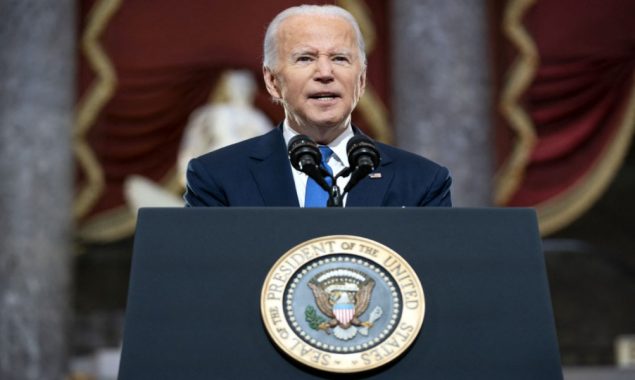Bangladesh eyes $80 billion exports by 2024
DHAKA: The Bangladeshi government has formulated a new export policy with a...

Image: File
WASHINGTON: The US consumer prices jumped last year at the fastest pace in four decades, the government confirmed on Wednesday, underscoring the potent inflation wave that has sapped public support for President Joe Biden even as the economy recovers from the pandemic.
The seven per cent increase in the Labor Department’s consumer price index (CPI) over the 12 months to December was the highest since June 1982, as prices rose for an array of goods, especially housing, cars and food.
Since taking office last January, Biden has presided over an economy that has expanded rapidly and seen millions of people who lost their jobs to the Covid-19 pandemic return to work.
But a collision between rebounding demand, labor shortages and global supply chain snarls that made crucial components like computer chips scarce caused prices last year to climb upwards at an ever-faster rate.
In a statement, Biden said the latest data contained signs of “progress” as inflation in some key sectors slowed.
“At the same time, this report underscores that we still have more work to do, with price increases still too high and squeezing family budgets,” he said.
But if relief is near, economists say it may not come particularly quickly.
“The peak is close, but the speed of the coming downshift is uncertain,” said Ian Shepherdson of Pantheon Macroeconomics.
For the Republican opposition, the report underscored their belief that the Democratic president has mishandled the recovery.
“This trend isn’t ‘transitory,’ and it’s all happening under Democrats’ one-party control,” tweeted Kevin McCarthy, the top Republican in the House of Representatives, of which his party is seen as favored to win control in elections in November.
The White House has attempted to lower prices by sorting out supply chains to relieve shortages and address alleged price fixing in industries like meatpacking, but the most potent actor against inflation is the independent Federal Reserve.
Central bankers already have indicated they are ready to raise interest rates from zero in the coming months, and many observers see the first increase as soon as March.
Kathy Bostjancic of Oxford Economics said the Fed now sees getting inflation back towards its two-per cent goal as its “top priority,” and could raise rates as many as four times this year.
From cars to food
Prices for shelter, including rental properties, have been one of the main contributors to inflation, rising 4.1 per cent in the year, while food rose 6.3 per cent, the Labor Department said.
However, in both cases, the December monthly increase was smaller than in the prior month.
After slumping during the economic crisis in 2020, energy prices rebounded strongly last year with a 29.3 per cent gain, the report said. But in December, energy costs contracted, falling 0.4 per cent from November, indicating Americans may soon see relief at gas stations and on their heating bills.
There was no such respite for used car prices, another main driver of inflation in the year, which jumped 3.5 per cent in December and 37.3 per cent over the course of 2021, according to the data.
Food and energy prices can be volatile, but with those items stripped out, consumer prices rose more than expected with a 0.6 per cent gain compared to November.
For the year, they were up 5.5 per cent, the highest since February 1991.
Approaching peak?
There were indications in the data that the price surge may be ebbing.
The overall CPI growth slowed to 0.5 per cent in December, less than the 0.8 per cent increase in the prior month.
The Fed’s final Beige Book survey of economic conditions for 2021 released Wednesday said that some businesses “noted that price increases had decelerated a bit from the robust pace experienced in recent months.”
Some of the major drivers of inflation will ease over the course of this year, Shepherdson predicted, including the shortage of real estate that has pushed home prices and rents upwards, and the scarcity of semiconductors that has crippled automobile assembly lines.
While annualised consumer prices may eventually peak at a level higher than in December “the run of big increases is over, and it will start to fall in March,” he said.
Catch all the Business News, Breaking News Event and Latest News Updates on The BOL News
Download The BOL News App to get the Daily News Update & Follow us on Google News.